Lessons from Past Climate Predictions: Arctic Sea Ice Extent
 Predicting the annual Arctic sea ice extent minimum has become a bit of a sport, with many varying groups submitting predictions to the Study of Environmental Arctic Change (SEARCH), for example. Here we'll examine a few such predictions made for the 2010 and 2011 seasons.
Predicting the annual Arctic sea ice extent minimum has become a bit of a sport, with many varying groups submitting predictions to the Study of Environmental Arctic Change (SEARCH), for example. Here we'll examine a few such predictions made for the 2010 and 2011 seasons.
2010
In late 2009 and early 2010, Anthony Watts and Steve Goddard predicted a 0.5 million square kilometers (km) recovery from the 2009 minimum of 5.25 million square km, or between 5.7 and 5.8 million square km. This was the size of the short-term Arctic sea ice extent 'recovery' from 2008 to 2009, and Watts and Goddard felt it was a good bet that a similar short-term 'recovery' would occur in 2010. Watts also posted a poll on his website, and nearly 70% of WUWT readers predicted that the 2010 minimum Arctic sea ice extent would exceed that in 2009 (a further 6.8% said it would be "near normal", whatever that means).
Steve Goddard later revised his estimate downward, predicting a 5.5 million square km minimum in 2010 on WattsUpWithThat (WUWT) as late as August 22 of last year. He later revised his prediction down even further to 5.1 million square km less than a month prior to the actual annual minimum, which occurred on 17 September 2010 (though predicting the minimum 3 weeks ahead of time is less than impressive).
On 26 July 2010, tamino weighed in with his own prediction by fitting a quadratic trend line to the annual September sea ice extent data (Figure 1).
"So here’s a simple projection: I’ve extrapolated the trend line to this year. Which gives a predicted September extent of 4.78 million km^2 (plotted as the red dot on the graph). I’ll call that my forecast for the summer minimum....I expect this summer’s extent to be less than last year’s. I’ll give that an 89% chance of happening."
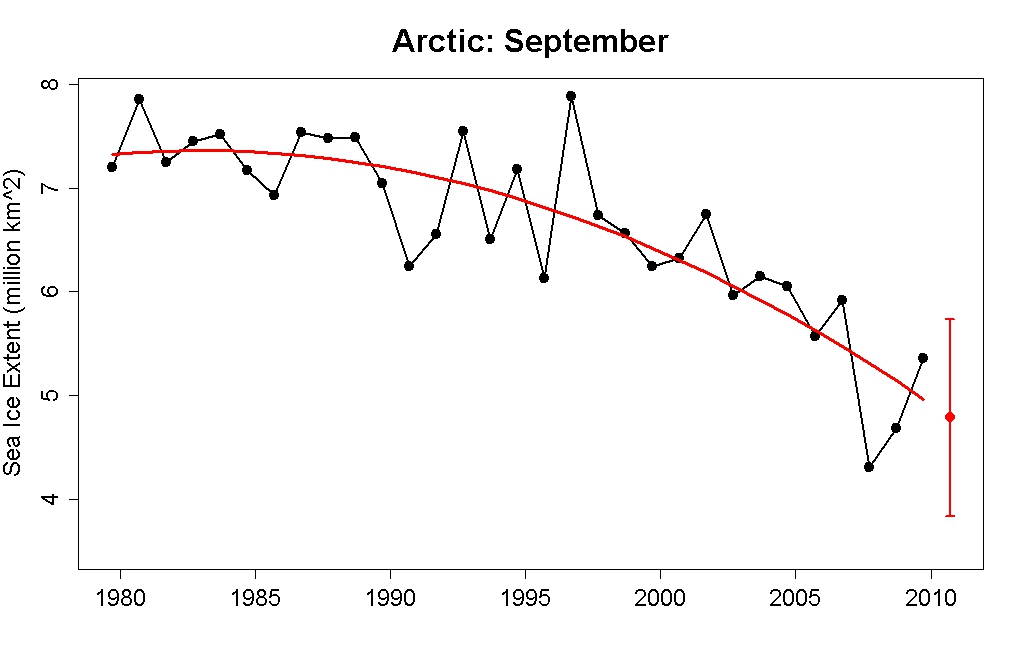
Figure 1: tamino's plot of September Arctic sea ice extent data fitted with a quadratic trend, and his 2010 minimum prediction
Skeptical Science's own Dikran Marsupial advanced his own after-the-fact prediction of 4.93 million square km for the 2010 minimum (Figure 2):
"I obtained from data for Arctic sea ice extent from 1979-2009...I then fitted a Gaussian process model, using the excellent MATLAB Gaussian Processes for Machine Learning toolbox (the book is jolly good as well). I experimented with some basic covariance functions, and chose the squared exponential, as that gave the lowest negative log marginal likelihood (NLML). The hyper-parameters were tuned by minimising the NLML in the usual way."
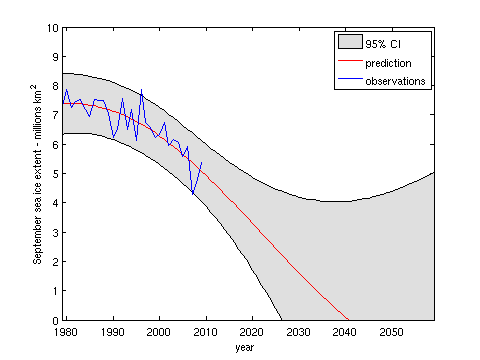
Figure 2: Dikran Marsupial's Arctic sea ice extent model prediction (red line, gray bars) vs. observations (blue)
That's quite a difference, with climate "skeptics" Watts and Goddard initially predicting a minimum 2010 Arctic sea ice extent of 5.75 million square km and 70% of WUWT readers believing it would exceed the 2009 minimum, vs. tamino's 4.78 million square km prediction with 89% likelihood of not exceeding the 2009 minimum, and Dikran's 4.93 million square km prediction.
So who was right? Not surprisingly, those who used the long-term trend to predict future changes (tamino and Dikran Marsupial). The actual 2010 minimum was 4.81 million square km. Goddard and Watts were wrong by nearly 1 million square km (nearly 20%), 70+% of WUWT readers were wrong about 2010 exceeding the 2009 minimum extent, while tamino's projection was almost perfect (his best estimate was off by just 0.6%), and Dikran's best estimate was only off by 2.5%. Goddard's revised prediction made ~3 weeks before the minimum occurred was also off by 0.3 million square km (6%).
Dikran Marsupial also notes that using a quadratic covariance function yields a very different, "skeptic"-like result of 5.4 million square km for the 2010 minimum, which he notes shows "how sensitive projections can be to the assumptions on which they are based."
2011
This year, perhaps as a result of their poor 2010 performance, Watts and Goddard declined to make Arctic sea ice extent minimum predictions. Weatherman Joe Bastardi took up the reins for the optimistic "skeptic" annual prediction. In a video you can watch via Climate Progress and Neven's Arctic Sea Ice blog. Bastardi claimed:
"we're gonna recover dramatically here with the cold that is coming over the next 9 to 12 months. I think next year you're going to see the latest start to the sea ice melt that we've seen in a long time"
In the video, Bastardi created a hand-drawn graph to illustrate his 2011 Arctic sea ice extent prediction (Figure 3).
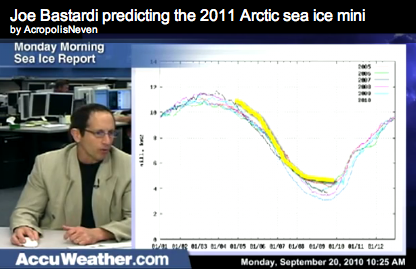
Figure 3: Joe Bastardi's hand-drawn 2011 Arctic sea ice extent prediction (made on 20 September 2010).
Here Bastardi is using an Arctic sea ice extent graph from DMI, whose data only extend back as far as 2005. We'll instead use JAXA, whose data extend back to 2002 (and whose data are easier to obtain). Bastardi clarified his prediction in a comment published on WUWT:
"My forecast for next year is for sea ice to melt only to levels we saw back in 2005, or 06. If I had to put a number on it, I think it would be around 5.5 at its lowest"
WUWT readers mirrored Bastardi's 2011 minimum prediction, after taking a vote in May 2011 and submitting their prediction to SEARCH in June 2011, summarized by Watts:
PAN-ARCTIC OUTLOOK – WUWT (acronym for WattsUpWithThat.com)
1. Extent Projection: 5.5 million square kilometers
2. Methods/Techniques: web poll of readers
3. Rationale: Composite of projections by readers, projection bracket with the highest response is the one submitted.
4. Executive Summary: Website devoted to climate and weather polled its readers for the best estimate of 2011 sea ice extent minimum by choosing bracketed values from a web poll which can be seen at: http://wattsupwiththat.com/2011/05/19/sea-ice-news-call-for-arctic-sea-ice-forecasts-plus-forecast-poll/
15.64% chose 5.5 million km2 or greater, with 13.09% choosing 5.0 to 5.1 million sq km2 as the second highest vote.
5. Estimate of Forecast Skill: none
The WUWT prediction was the second-most optimistic prediction submitted to SEARCH in June 2011.
In October 2010, tamino also made a 2011 Arctic sea ice extent minimum prediction again based on extrapolation of a quadratic trend (Figure 4):
"Now that NSIDC data for this September are available, I’ll do as I did before: fit a quadratic trend to the September average data from NSIDC, then use that trend to predict that next year’s September average from NSIDC, and next year’s JAXA minimum, will be 4.63 +/- 0.9 million km^2. After all, the best predictor of future behavior is past behavior: the trend continues."
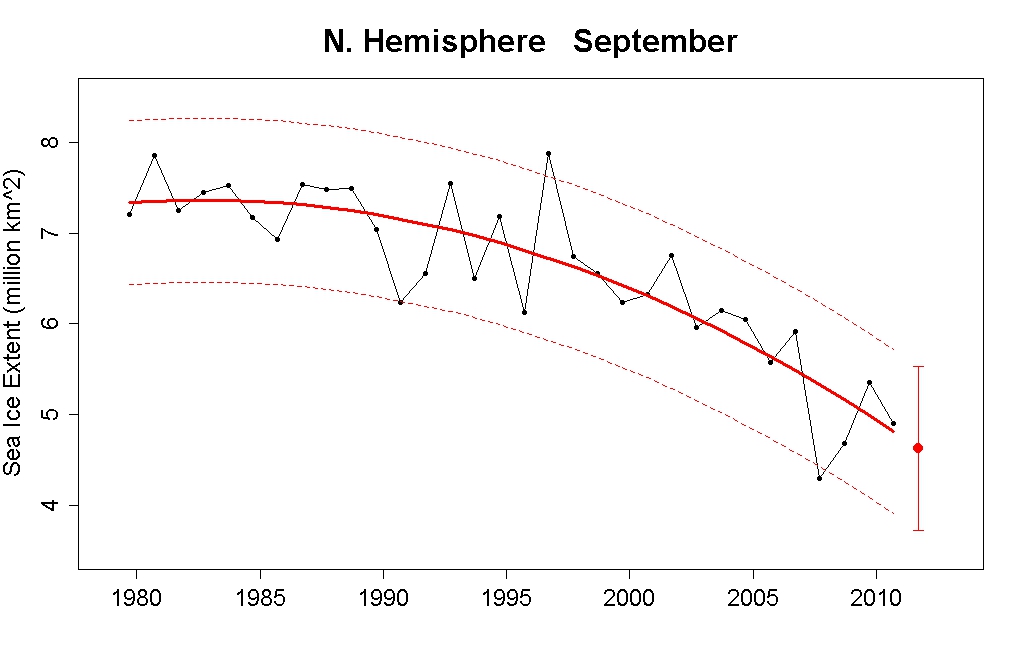
Figure 4: tamino's plot of September Arctic sea ice extent data fitted with a quadratic trend, and his 2011 minimum prediction.
Dikran Marsupial's model (Figure 2) predicts a 4.77 million square km minimum for 2011. Figure 5 is an approximate re-creation of Bastardi's hand-drawn prediction, placing the 2011 minimum at 5.5 million square km, plus WUWT and tamino's predictions.
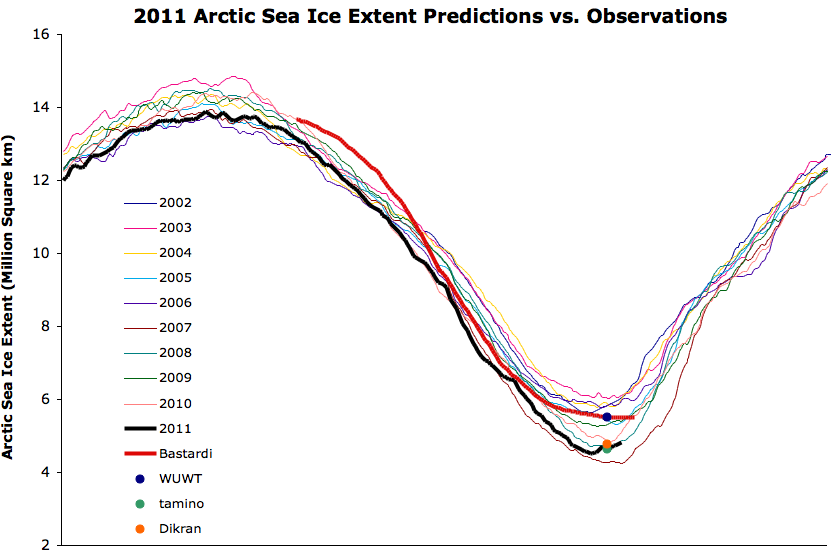
Figure 5: JAXA Arctic sea ice extent data, with an approximate re-creation of Joe Bastardi's 2011 prediction from Figure 1 (red), WUWT readers' predicted minimum (blue dot), tamino's predicted minimum (green dot), Dikran Marsupial's predicted minimum (orange dot), and the actual 2011 data (black).
Clearly Bastardi and WUWT's predictions did not fare well. Contrary to Bastardi's prediction, the melt season did not begin late, and the annual minimum (4.53 million square kilometers [km]) was approximately 1 million square km (21%) less than the "skeptic" prediction. On the other hand, tamino once again fared very well, with his best estimate missing the mark by just 0.1 million square km (2.2%), and Dikran Marsupial fared reasonably well, overestimating the 2011 minimum by 0.24 million square km (5%).
Ice Age/Thickness/Volume
Steven Goddard declined to make an Arctic sea ice extent prediction for 2011 (perhaps being discouraged by his poor 2010 prediction), but did make a prediction about Arctic sea ice thickness:
"My forecast is that come the end of September, the amount of multi-year ice will again increase relative to last year, as it has done every year since 2008. In 2013 there should be an increase in the amount of five year old ice, because that is when the 2008 ice will have aged five years."
Firstly, "every year since 2008" encompassed a whopping two years of data when Goddard made that statement. Figure 6 shows the data from September (end of summer), updated by NSIDC through 2011. Bear in mind that this is a graph of percent of total ice extent, which is only an accurate representation of the amount of ice if the the total amount remains constant, which is not the case.
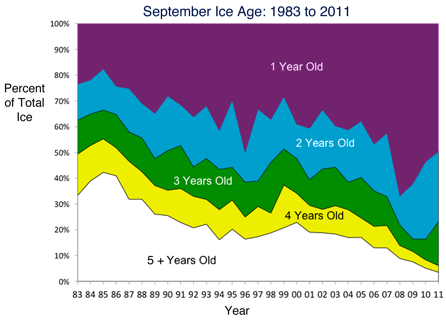
Figure 6: NSIDC Arctic sea ice age from 1983 through 2011 (Source)
As you can see, the percentage of 2-year-old ice has increased since 2008. The percentage of 3-year-old ice declined from 2008 to 2009, but increased from 2010 to 2011. The percentage of 4- and 5-year-old ice has declined consistently over essentially the entire decade. The total amount of multi-year ice did increase slightly from 2010 to 2011, due to the increase in 2- and 3-year-old ice. However, sea ice thickness declined due to the loss of 4- and 5-year-old ice.
Because of this declining sea ice age/thickness, even though sea ice extent did not break the 2007 record, sea ice volume did set a new record low in 2011. According to the Pan-Arctic Ice Ocean Modeling and Assimilation System (PIOMAS), both 2010 and 2011 set new record lows for Arctic sea ice volume, and like the sea ice age/thickness data, has declined steadily since 2007 (Figure 7).

Figure 7: PIOMAS Arctic sea ice volume anomaly and trend.
Arctic Optimism is Skating on Thin Ice
Climate "skeptic" Arctic sea ice extent predictions were too optimistic by approximately 20% in both 2010 and 2011, while tamino's prediction based on a quadratic declining trend (a.k.a. a "death spiral") has been exceptionally accurate. We've only examined two years' worth of predictions here, but tamino's and Dikran's projections were based on applying a quadratic trend to 30 years worth of data.
In short, "skeptic" optimism about an Arctic sea ice recovery seem very badly misplaced. The planet (especially the Arctic) is warming rapidly, and the decline in both Arctic sea ice extent and volume is accelerating faster than climate models project.
We have to wonder if WUWT will produce its third consecutive overly optimistic Arctic sea ice prediction in 2012, or if "skeptics" will learn that their optimism is not based in reality. Canadian researchers reported this month:
"Canada’s Arctic ice shelves, formations that date back thousands of years, have been almost halved in size over the last six years"
So much for misplaced optimism.
Posted by dana1981 on Thursday, 6 October, 2011
 Predicting the annual Arctic sea ice extent minimum has become a bit of a sport, with many varying groups submitting predictions to the Study of Environmental Arctic Change (SEARCH), for example. Here we'll examine a few such predictions made for the 2010 and 2011 seasons.
Predicting the annual Arctic sea ice extent minimum has become a bit of a sport, with many varying groups submitting predictions to the Study of Environmental Arctic Change (SEARCH), for example. Here we'll examine a few such predictions made for the 2010 and 2011 seasons.







